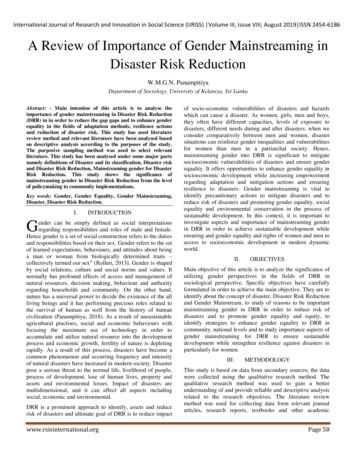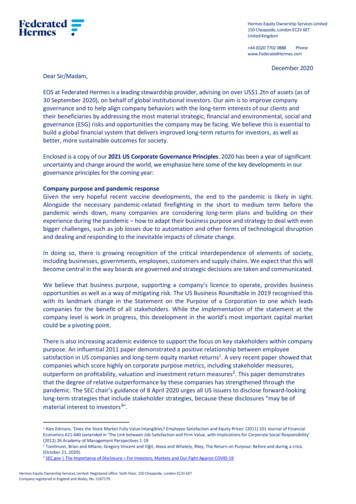Disaster Resilience: A Local To National Imperative
Disaster Resilience:A Local to rolinaChair,Commi*eeonIncreasingNa onalResiliencetoHazardsandDisastersNa onalResearchCouncil,TheNa owaFloodsConferenceMay31,2013CedarRapids,Iowa
!Number of federal disaster declarations is rising!In 2012 losses exceed 107 billion ( 58.5 billion insured)!More citizens are living in or moving to areas with prevalent naturalhazards!No person or place is immune from disasters or disaster-relatedlosses.!Communities and the nation face difficult fiscal, social, cultural,and environmental choices about the best ways to ensure securityand quality of life against disasters.The Problem
The Landscape of Roles and ResponsibilitiesInfrastructureLaws, regulations,infrastructure,data, Federal(14 cabinet-levelagencies) NGOs/FBOsIndustry groupsScience & researchState(50—different hazards,histories, capacities ) rical, educational,structural differences) , local codes & regulations, plans,preparedness, education, healthThe Problem
Study SponsorsDepartment of Agriculture Forest ServiceU.S. Army Corps of EngineersDepartment of EnergyU.S. Geological SurveyDepartment of Homeland Security andFederal Emergency Management AgencyNational Aeronautics and Space AdministrationNational Oceanic and Atmospheric AdministrationOak Ridge National Laboratory and the Communityand Regional Resilience InstituteTimelineStudy began, September 2010Five meetings (3 regional site visits)Report release, August 2012Disaster Resilience in America:Launching a National Conversation, November 2012Extra year and funds for dissemination
The Taskq Define “national resilience” and frame the primary issues related to increasingnational resilience to hazards and disasters in the United States;q Provide measures, baseline conditions, for resilience at the U.S. nationallevel;q Describe the state of knowledge about resilienceq Identify data and gaps and obstacles to action in order to increase resilience tohazards and disastersq Conclusions and recommendations about what approaches to elevate nationaldisaster resilience in the United States.
The TeamSusan L. Cutter, chair, University of South Carolina, Columbia, SCJoseph A. “Bud” Ahearn, CH2M Hill Ltd., Greenwood Village, COBernard Amadei, University of Colorado at Boulder, COPatrick Crawford, Feeding America, Chicago, ILGerald E. Galloway, University of Maryland, College Park, MDMichael F. Goodchild, University of California, Santa Barbara, CAHoward C. Kunreuther, University of Pennsylvania, Philadelphia, PAMeredith Li-Vollmer, Public Health Seattle & King County, WashingtonMonica Schoch-Spana, University of Pittsburgh Medical Center, Baltimore, MDSusan C. Scrimshaw, The Sage Colleges, Troy, NYEllis M. Stanley, Sr., Dewberry, Los Angeles, CAGene Whitney, Congressional Research Service (retired), Washington, DCMary Lou Zoback, Stanford University, Stanford,CANRC StaffLauren Alexander-Augustine, Associate Executive Director, Division on Earth and Life Studiesand Director, Disasters RoundtableElizabeth A. Eide, Study Director, and Director, Board on Earth Sciences and ResourcesEric J. Edkin, Senior Program AssociateNeeraj Gorkhaly, Research Associate
What is Resilience?The ability to prepare and plan for,absorb, recover from, or moresuccessfully adapt to actual orpotential adverse eventsHistoric flood levels inundate Mercy Medical Center 1st floor andbasement levels; photo by Dr. Blaine Houmes/Mercy Medical Center,available at cting-hospitals-from-severe-weather/What we learned from theIowa site visit1. The value of an all-hazardsapproach in preparedness,response, and mitigation.2. The significance and importanceof local capacity.3. Promoting resilience by keepingthe memory alive (AfricanAmerican Museum; Czech andSlovak Museum, high watermarks)4. Active engagement of allstakeholders (business,community organizations,citizens, universities, electedofficials).5. The role and significance ofadaptive behavior and solutions.
So, What Do We Do to Enhancethe Nation’s Resilience toDisasters?Iowa River in Iowa CityPhoto: Susan Cutter
Establish a National “Culture Of Resilience”q Communities, and their governancestructures and systems, need to be robustand collaborative.q Long-term shifts in physical and culturalapproaches are needed.q Linked bottom-up and top-downnetworks are important for managing riskand increasing resilience.q Community resilience requiresidentification and acceptance of specificroles and responsibilities for government,the private sector, and local stakeholders.Photo: Port of Los Angeles upgrade to address risk and sustainabilitySource: Gerry GallowayA necessary first step to strengthen thenation’s resilience and provide theleadership to establish a national“culture of resilience” is a full and clearcommitment to disaster resilience by thefederal government.
Specific Steps toward a “Culture Of Resilience”Build local capacity—resilience from the bottom-up.Identify, assess, and reduce disaster risk.Build the case for making long-term investments in resilience.Measure progress.Develop national resilience vision and policy.Photo: Cedar Rapids, IA during the 2008 floodingSource: AP photo/Jeff Robertson
Build Local Capacity—Resilience from the Bottom-UpCommunity resilience begins with strong local capacity.Universal Bottom-Up Stepso Engage the community in disaster policy planningo Link public & private infrastructure performance to resiliencegoalso Communicate risks, promote a culture of resilienceo Organize communities and families to prepare for disasterso Adopt sound land-use practices and adopt and enforce buildingcodesThe nation’s communities are unique and the risks faced by every community varyaccording to local hazards.
Identify, Assess, and Reduce Disaster RisksReducing risk requires a process of identifying risk, developing and implementing astrategy to deal with that risk, and keeping that strategy up to date.A variety of tools and approaches are availableto manage disaster risk:Structural: e.g., levees, dams, disasterresistant construction, “smart” building, andwell-enforced building codesNonstructural: e.g., natural defenses, riskmapping, zoning ordinances, economicincentives, hazard forecasting/warning,insurance, and catastrophe bondsComplementary risk reduction andrisk-spreading tools and measures arerequired.
Demonstrate the Case for Resilience Investments:Assessing the Challengeq Valuation of a community’s assets—including infrastructure and assets with social,cultural, and environmental value—is importantto make resilience investment decisions.q Demonstrating that communityinvestments in resilience will yieldmeasurable short- and long-term benefits iscritical for sustained commitment to increasingresilience.q Knowing the patterns of disaster lossesallows communities to understand where theimpacts are the greatest and what factors drivetheir exposure and vulnerability.Photo: National Czech and Slovak Museum, Cedar Rapids, IA March 2011.Source: Susan CutterExisting loss and inventory databases inthe United States are useful for certainkinds of analyses, but improvement inmeasurements, accuracy, and consistencyare needed.
Measure Progressq Critical dimensions of a consistentresilience measurement system are:Ø the ability of critical infrastructure tocontinue to perform;Ø social factors (e.g., health,socioeconomic status) that enhance orlimit a community’s ability to recover;Ø indicators of the ability of buildingsor structures to withstand differentdisasters (e.g., building codes, adoptedand enforced);Photo: Elevated home near Gulfport, MS; Source: E. EideØ factors that capture the special needsof individuals and groups.The nation needs a consistent basis for measuring resilience.
Develop Resilience Policy and Visionq Strong governance at all levels is key.q National policies need to take a long-termview of community resilience.q Gaps exist in policies and programs amongfederal agencies in all parts of the resilienceprocess.q Gaps result from: the legislative authority within whichagencies operate lack of effective coordination of theroles and responsibilities lack of a unified resilience vision.The nation does not have a overall vision orcoordinating strategy for resilience.
Recommendationsq Government should support the creation and maintenance of broad-basedcommunity resilience coalitions at local and regional levels.q Community commitment to and investment in risk management strategies.q Establish a national disaster database.q Develop a National Resilience Scorecard.q Federal agencies should incorporate national resilience as a guidingprinciple.q All federal agencies should ensure they are promoting and coordinatingnational resilience in their programs and policies.
Next StepsShort-term: dissemination & outreach through September 2013q November 30, 2012—Event in Washington, “DisasterResilience in America: Launching a National Conversation”! Four printed products (study report, standalone summary,2 workshop reports)! 12,000 downloads of PDFs (report and derivatives; nationaland international interest)! Website: http://nas-sites.org/resilience (including interviewswith November 30 panelists, keynotes; webcast of event)! 9 DC briefings (sponsors, White House Nat’l Security staff,House Committee on Homeland Security, Sen. Landrieu’soffice, Sen. Kerry’s office, Senate Legislative Assistants, WhiteHouse Subcommittee on Disaster Reduction, Assistant Sec’yLurie at DHHS, Chief Tidwell at USFS)! 18 invited briefings by committee members/staff to variousorganizations (NAIC, NACo, NVOAD, NCSE, Oxfam, Nat’l HealthPreparedness Summit, NATO, etc more scheduled)
Next Steps: Longer-termNumerous requests—national, state, local, and international—to continue theconversation and NRC engagement beyond September 2013Wrap-up/launch event with sponsors, other potential sponsors—Autumn 2013q Four pillars:Ø Measure resilience in communitiesØ Build community coalitionsØ Manage and communicate riskØ Share information and data to build resilient communitiesq Future follow-on activity may include:Ø convening regional meetings, workshops, strategy sessionsØ serving as a neutral convening and meeting venueØ coordinating regular webinarsØ helping to facilitate community exchangesØ fostering development of additional ad hoc activities
Disaster Recovery : Opportunities to Enhance Resilience! Establish a local and state cultureof resilience with a shared vision andpolicy! Build local capacity—resilience fromthe bottom-up (and link to top-downefforts)! Identify, assess, communicate, andreduce disaster risk! Build the case for long-termresilience investments (use data andinformation)! Measure progress! Adopt sound land-use practices,enforce building codes, build saferand smarter! Use an all-hazards approachOrtley Beach, NJ. Photo by S. L. CuterMoore, OK . Photo: New York Daily News
Characteristics of a Resilient Nation in 2030q Individuals and communities are their own first line of defense against disasters.q National leadership in resilience exists throughout federal agencies andCongress.q Community-led resilience efforts receive federal, state, and regional investmentand support.q Site-specific risk information is readily available, transparent, and effectivelycommunicated.q Zoning ordinances are enacted and enforced. Building codes and retrofitstandards are widely adopted and enforced.q A significant proportion of post-disaster recovery is funded through privatecapital and insurance payouts.q Insurance premiums are risk based.q Community coalitions have contingency plans to provide service particularly tothe most vulnerable populations during recovery.q Post-disaster recovery is accelerated by infrastructure redundancy andupgrades.A resilient nation in 2030 also has a vibrant and diverse economy and a safer,healthier, and better educated citizenry than in previous generations.
http://nas-sites.org/resilience/
Specific Steps toward a “Culture Of Resilience” Build local capacity—resilience from the bottom-up. Identify, assess, and reduce disaster risk. Build the case for making long-term investments in resilience. Measure progress. Develop national resilie
6 DISASTER RISK REDUCTION FOR COMMUNITY RESILIENCE: A SYNTHESIS OF LESSONS FROM MORE THAN A DECADE OF DISASTER RISK REDUCTION PROGRAMMING 5 DISASTER RISK REDUCTION FOR COMMUNITY RESILIENCE: A SYNTHESIS OF LESSONS FROM MORE THAN A DECADE OF DISASTER RISK REDUCTION PROGRAMMING Coping capacity can be significantly improved if vulnerable people can anticipate an event which allows
Strategy for Disaster Reduction. An alignment of the terminology used in disaster risk reduction in Africa with the internationally acceptable concepts is logical. 2.1 Disaster Although the focus of disaster reduction is not on any actual disaster event itself, disaster remains the main focus. Thus our efforts must be geared towards the
namely Disaster and its classification, Disaster risk and Disaster Risk Reduction, Mainstreaming gender for Disaster Risk Reduction. IV. DISASTER AND ITS CLASSIFICATION Disaster is a phenomenon which can identify from the history of human civilization and it can be simply defined as an event
There are three important phases in hospital emergency disaster management plan 1) Pre-disaster phase 2) Disaster Phase 3) Post Disaster Phase Pre-Disaster Phase a) Planning: Most of the assessment and planning is done in the pre-disaster phase, the hospital plans are formulated and then discussed in a suitable forum for approval. b) Preparation
1. Post-Disaster Recovery and Disaster Risk Reduction require support from community participation in improving the quality and objectives of Disaster Management; 2. Community-based Disaster Risk Reduction is a key factor in participatory disaster management, including in post-disaster recovery, as indicated by best practices in Yogyakarta and .
community disaster—recognize that preparing for long-term disaster recovery demands as much attention as preparing for short-term response. After a major disaster, the recovery process takes months and even years to bring a community back to a "new normal" and as strong as or better than before the disaster. Disaster Recovery: A Local
Resilience is the ability to prepare and plan for, absorb, recover from, and more successfully adapt to adverse events. The committee’s definition reflects the many facets of resilience and its relevance before, during, and after a disaster. While resilience is rooted in the local commu
2 Tomlinson, rian and Milano, Gregory Vincent and Yiğit, Alexa and Whately, Riley, The Return on Purpose: efore and during a crisis (October 21, 2020). 3 SEC.gov The Importance of Disclosure –For Investors, Markets and Our Fight Against COVID-19 Hermes Equity Ownership Services Limited 150 Cheapside, London EC2V 6ET United Kingdom 44 (0)20 7702 0888 Phone www.FederatedHermes.com . Hermes .























